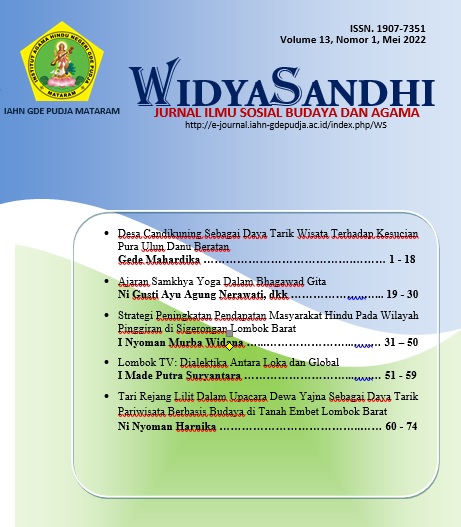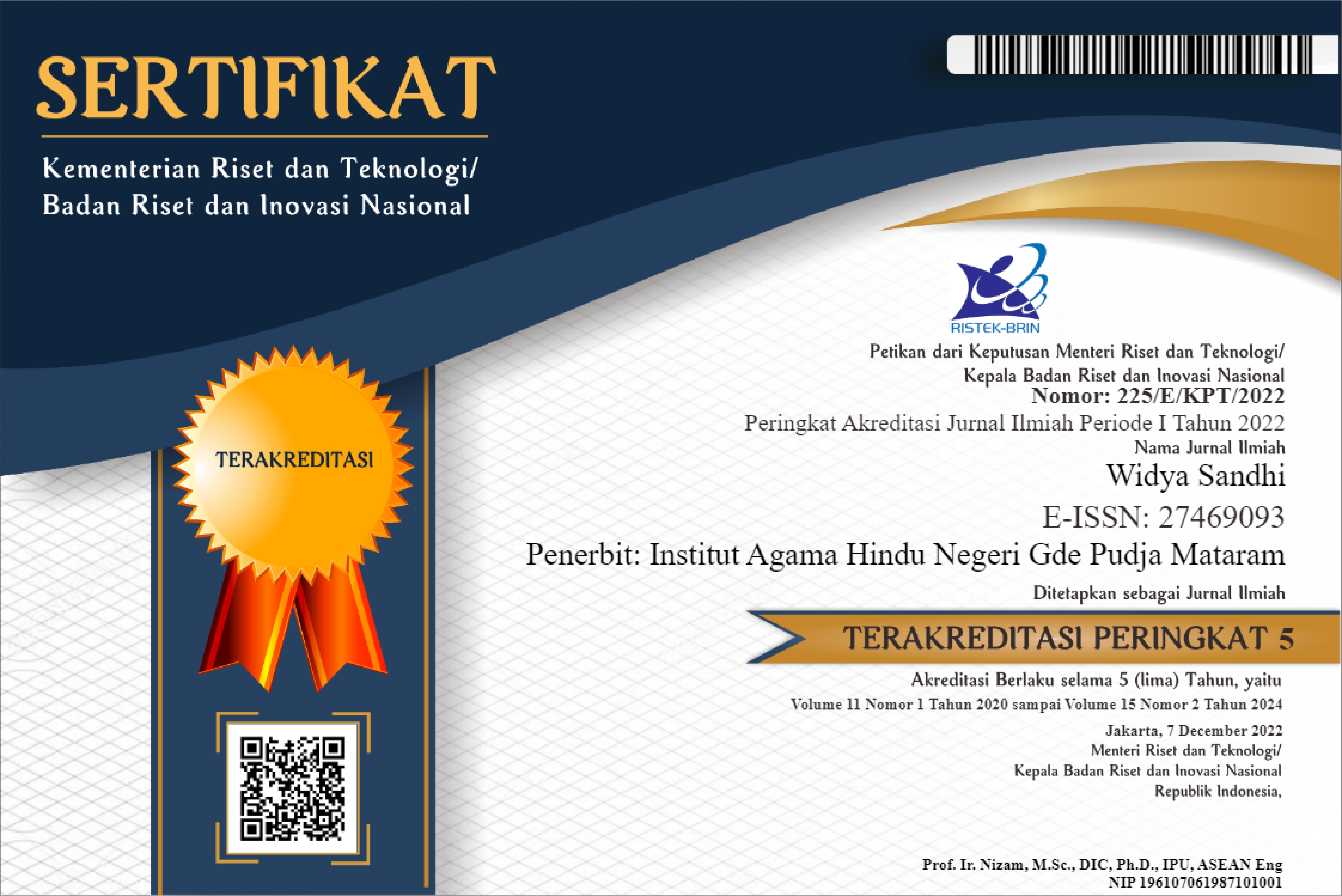AJARAN SAMKHYA YOGA DALAM BHAGAVAD GITA
Abstract
Bhagavadgita. The teachings of this samkhya provide different understandings of
purusa and prakerti which are different, but integrated with one another. In the essence
of the Bhagavadgita which describes the philosophy of life in which every human being
will leave or experience liberation from worldly life. So that humans must accept the
challenge between life and death and dare not to feel afraid to fight the situation because
in this world only a puppet player who is moved by the hand of God. The purpose of this
study is to obtain the values contained in the teachings of samkhya yoga because this
teaching is not very easy to understand and deepen understanding in order to be able to
understand and understand the purpose of the teachings. Thus, the teachings of samkhya
provide humans with an extraordinary understanding of life for this journey, because this
life is like a cycle of birth and death, above, below and in the middle. Therefore, the life
of this universe no one knows how the next life will be.
References
Ali, M. (2010). Filsafat India . Sanggar Luxor.
Darmayasa. (2015). Bhagavad Gita (Nyanyian Tuhan). Denpasar: Yayasan Dharma.
Hadiwijono, H. (1985). Sari Filsafat India. Jakarta: Gunung Mulia.
Hasan, M. I. (2002). Pokok-Pokok Materi Metodologi Penelitian dan Aplikasinya.
Jakarta: Penerbit Ghalia Indonesia .
Kompasiana, 5. A. (2020, April 16). Agama, Atheisme, Menghadirkan Sorga. Retrieved
from https://www.kompasiana.com/michusa/57a47649109373612d1bb25f/agamaatheisme-
menghadirkan-sorga
Ngurah, I. G. (1999). Buku Pendidikan Agama Hindu Untuk Perguruan Tinggi.
Surabaya: Paramita.
Pasraman. (2020, Oktober 31). Bab I Ajaran Samkya dan Yoga. Retrieved Mei 15, 2022,
from https://pasraman.com/knowledgebase/bab-i-ajaran-samkya-dan-yoga/
Pudja, G. M. (2005). Bhagawad Gita (Pancama Veda). Surabaya: Paramita.
Putra, N. P. (2014). Kamu Adalah Tuhan. Denpasar: Media Hindu.
Sumawa, I. W. (1996). Materi Pokok Darsana (PAHD2434/4SKS Modul 1-12)Direktorat
Jendral Bimbingan Masyarakat Hindu dan Buddha. Jakarta.
Suparta, I. K. (2015, Desember). Filsafat Samkhya Ajaran Dinamisme Dalam Hindu.
Widya Genitri, 7(1), 82-86.
Titib, I. M. (1996). Veda Sabda Suci (Pedoman Praktis Kehidupan. Surabaya: Paramita.
Wayan, M. I. (1999). Sistem Filsafat Hindu (Sarva Darsana Samgraha). Surabaya:
Paramita.
Yoga, S. (2021). Samkhya Yoga. Retrieved Maret 22, 2022, from
https://kk.sttbandung.ac.id/id3/2-3042-2940/Samkhya-Yoga_107145_kksttbandung.
html

This work is licensed under a Creative Commons Attribution-NonCommercial-ShareAlike 4.0 International License.
Authors who publish with this journal agree to the following terms:
- Authors retain copyright and grant the journal right of first publication with the work simultaneously licensed under a Creative Commons Attribution-ShareAlike 4.0 International License. that allows others to share the work with an acknowledgment of the work's authorship and initial publication in this journal.
- Authors are able to enter into separate, additional contractual arrangements for the non-exclusive distribution of the journal's published version of the work (e.g., post it to an institutional repository or publish it in a book), with an acknowledgment of its initial publication in this journal.
- Authors are permitted and encouraged to post their work online (e.g., in institutional repositories or on their website) prior to and during the submission process, as it can lead to productive exchanges, as well as earlier and greater citation of published work (See The Effect of Open Access).







.jpg)




